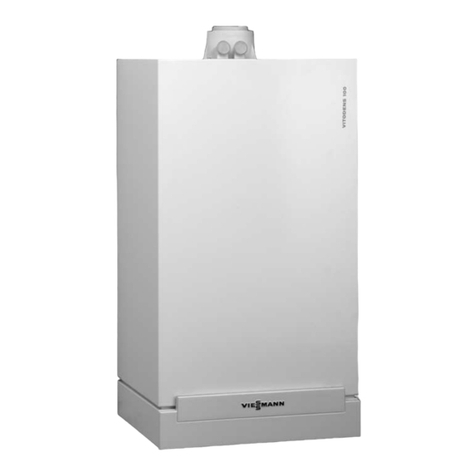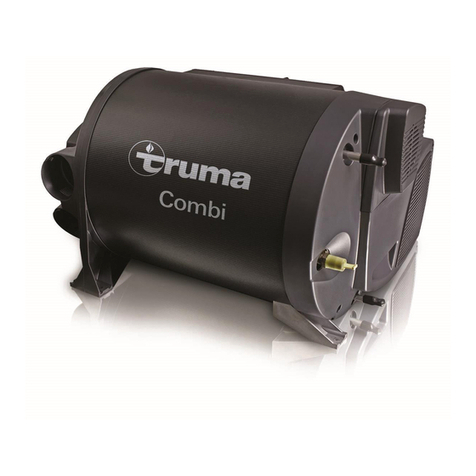7
This appliance must be installed by an authorised
person.
Non-compliance with installation instructions or incor-
rect installation can result in endangerment of persons
and property.
This appliance shall be installed in accordance with the manu-
facturer’s installation instructions, local gas fitting regulations,
municipal building codes, electrical wiring regulations,
AS 5601/2004 “Gas Installations”, and any other statutory
regulations.
Intended use
This device was designed for installing in vehicles (motor
homes and caravans). Other applications are also possible
following consultation with Truma.
Vehicles for hazardous materials
Combustion heaters for gaseous fuel are not permitted.
Approval
Declaration of conformity
The heater E 2400 (Australia) is tested and approved accord-
ing AS 4556/2000 and fulfils the standard.
The heater complies with the interference suppression
directive 72/245/EEC for vehicle engines with annexes
2004/104/EC, 2005/83/EC and 2006/28/EC.
AGA approval number
7550
5375
The year when the equipment was first taken into oper-
ation must be indicated with a check on the type plate.
Regulations
Guarantee claims, warranty claims and acceptance of liability
will be ruled out in the event of the following:
– modifications to the unit (including accessories),
– modifications to the exhaust duct and the cowl,
– failure to use original Truma parts as replacement parts and
accessories,
– failure to follow the installation and operating instructions.
It also becomes illegal to use the appliance, and in some
countries this even makes it illegal to use the vehicle.
In-vehicle installations must comply with the technical and
administrative regulations of the respective country of use
(e.g. AS 5601/2004 for vehicles). The national regulations and
rules must be complied with.
In other countries always observe the respectively valid
regulations.
For further details on the rules and regulations in the respec-
tive country of designation, please contact our agencies
abroad (see www.truma.com).
Installation instructions Choice of location
Always install the appliance and its exhaust duct in such a
way that it is always easily accessible for service work and
can be removed and installed easily.
This appliance can be installed without any clearance to com-
bustible materials providing the surrounding materials will
withstand temperatures of up to 85 °C. The flue and warm air
ducts can also be installed without clearance providing only
Truma components supplied with the appliance are fitted.
Make sure that there is at least 10 mm clearance to com-
bustible materials around the warm air discharge vent and
500 mm in front of the vent. Locate the vent so that curtains,
bedding, etc. cannot be blown directly in front of or in contact
with the warm air vent.
Steps must be taken to ensure that the warm air outlet of the
heating system is never obstructed (see warm air distribution).
The installation space must have appropriate openings for the
circulating air return (see circulating air return).
Locate the heater in such a way that the cowl can be mount-
ed on the outside on a surface which is as straight and
smooth as possible.
For evenly distributed heating, the installation of the appliance
should be as much in the centre of the vehicle as possible,
and in such a way that the air distribution ducts can be routed
with approximately the same length.
The cowl must be placed in such a way that the exhaust gas
cannot find its way into the vehicle interior. The exhaust gas
cowl can only be installed through a vertical wall to the
outside, never through a horizontal surface.
The flue cowl must always vent to outdoors and
not into any annex or other enclosed area.
This outside surface must be exposed to wind from all
directions and, if possible, there should be no trim strips or
covers in this area, mount heater on an appropriate base,
if necessary.
The wall cowl is to be fitted in such a way that no tank nozzles
or tank ventilation apertures are located within 500 mm (R) of
it. In addition, no air discharge apertures for the living area or
window openings may be located with 300 mm of it.
300 mm
300 mm
R
If installing the cowl directly underneath a window
that will be opened, installation of an electric window
switch (part no. 34000-85800) is mandatory. The gas unit
must automatically switch itself off using the Truma automatic
shut-off facility if the window is opened (Accessories, part no.
39050-00800).
Refer to AS 5601/2004 – Gas Installations, for location re-
quirements of the flue terminal.



























